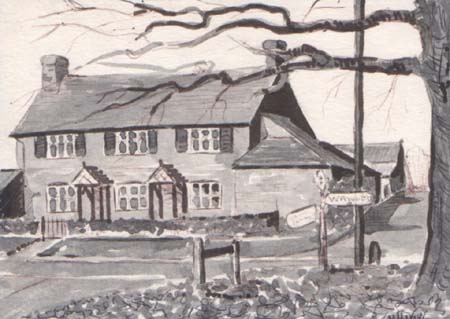|
The imposition of excise duties during the wars
with
France in the eighteenth century, encouraged
the smugglers to defraud the government of revenue. Smuggling had been confined
to
Kent and
Sussex, but when the Coast Blockade was set up
in that area on land and sea, smuggling became risky and
profits were lost. The
smugglers then moved along to the coasts of Hampshire
and
Dorset and encouraged the
local inhabitants in the trade. The broken coasts of these
counties gave many opportunities for the smugglers to land.
There were four main routes inland from the coast:-
to Dorchester
or Blandford "according to the demand and
whereabouts of the revenue men".
From
Christchurch and Boscombe via Ringwood and Verwood
(Burrow's Lane) to Cranborne.
From Poole
through Hamworthy
and the Lychetts to Blandford
.
From Canford through Colehill to Hinton Mills,
where the mill dam gave a secure hiding place while
waiting to hear whether the contraband was to go on to
Cranborne or back to Wimborne Minster.
 As the routes from
Christchurch, Boscombe and Canford converged on
Cranborne, it was in this area that the greatest efforts
were made to put an end to the illicit traffic. At Cranborne
and Verwood, excise officers and dragoons were quartered to
intercept smugglers on their way to Handley Chase. Many
encounters took place. As the routes from
Christchurch, Boscombe and Canford converged on
Cranborne, it was in this area that the greatest efforts
were made to put an end to the illicit traffic. At Cranborne
and Verwood, excise officers and dragoons were quartered to
intercept smugglers on their way to Handley Chase. Many
encounters took place.
A notorious smuggler, Gulliver, lived at a farm house at
nearby West Moors, now called Gulliver's
Farm. He married off his several daughters to the
local gentry. The family name of Gulliver was finally
changed by deed poll to that of Palmer.
For Much More detailed information about Gulliver then
follow the link (East Dorset Smugglers) which also contains details
of many more notorious smugglers in East Dorset and
Hampshire.
 On March 19th 1779 the
excise officer at Cranborne received information of a train
of twenty horses in the vicinity and duly despatch his
dragoons to intercept them. The
smugglers were overcome easily, but while returning to
Cranborne with the captured contraband, the dragoons were
overcome by fifty smugglers, losing all, including their
horses. The dragoons reached Cranborne with many wounded and
two dead. Reinforcement dragoons were sent from Wimborne
Minster and two smugglers were captured. One died of his
wounds and the other was hung in chains, it is said at
Eastworth. Heath Poult Inn at Eastworth was a clearing house
for smugglers (see drawing by H. Haworth). On March 19th 1779 the
excise officer at Cranborne received information of a train
of twenty horses in the vicinity and duly despatch his
dragoons to intercept them. The
smugglers were overcome easily, but while returning to
Cranborne with the captured contraband, the dragoons were
overcome by fifty smugglers, losing all, including their
horses. The dragoons reached Cranborne with many wounded and
two dead. Reinforcement dragoons were sent from Wimborne
Minster and two smugglers were captured. One died of his
wounds and the other was hung in chains, it is said at
Eastworth. Heath Poult Inn at Eastworth was a clearing house
for smugglers (see drawing by H. Haworth).
A notorious character of Cranborne, Dan, was one of the most daring of
the Dorset
smugglers, he was constantly under suspicion, by the excise
men. Eventually his
contraband hideout was found and the goods taken to the
Custom House at Cranborne. Dan brought in reinforcements
from Christchurch and broke into the Custom House removing
the contraband. Dan was never caught by the law but met an
untimely end being dragged in his stirrup by his horse. He
was a popular man and before his death established a Charity
at Verwood.
Captain "Hawkhurst"
it is said, controlled most of the smuggling gangs in the
country, and had an agent in Wimborne Minster "a
most highly respected man". The Poole Customs House
had an enormous
quantity of confiscated goods locked within, under guard by
excise men. Hawkhurst
heard of this and ordered all the smugglers in the area to
be in Poole
at a given day. One morning, with Hawkhurst at their head,
some marched through
Poole
to the Customs House, others hid in nearby houses. They opened fire, forced
their way into the customs house and removed the goods,
taking them by land and sea, the smugglers dispersing
throughout the country.
Although they were connected with illicit traffic
and brutal murders, the smugglers of Dorset
adder' a bright spot to Dorset
's history.
In 1791 the Noblemen of Cranborne Chase proposed
the disfranchisement of the Chase,
as their property and the public were being injured by the
"Chase Rights''. The Chase, they said, was a
den of temptation, vice and immorality, the parishes were
nests for deer stealers "bred to it by their
parents" and a harbour for smugglers who worked with
the deer stealers. It was not until 1829 that an Act of
Parliament was obtained for the disfranchisement of the
Chase, when it passed to
Lord Rivers and
his heirs.
Copyright © P Reeks.
|